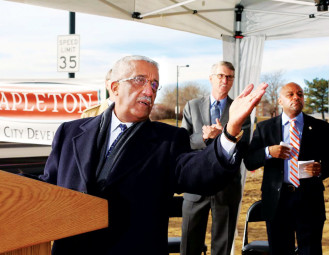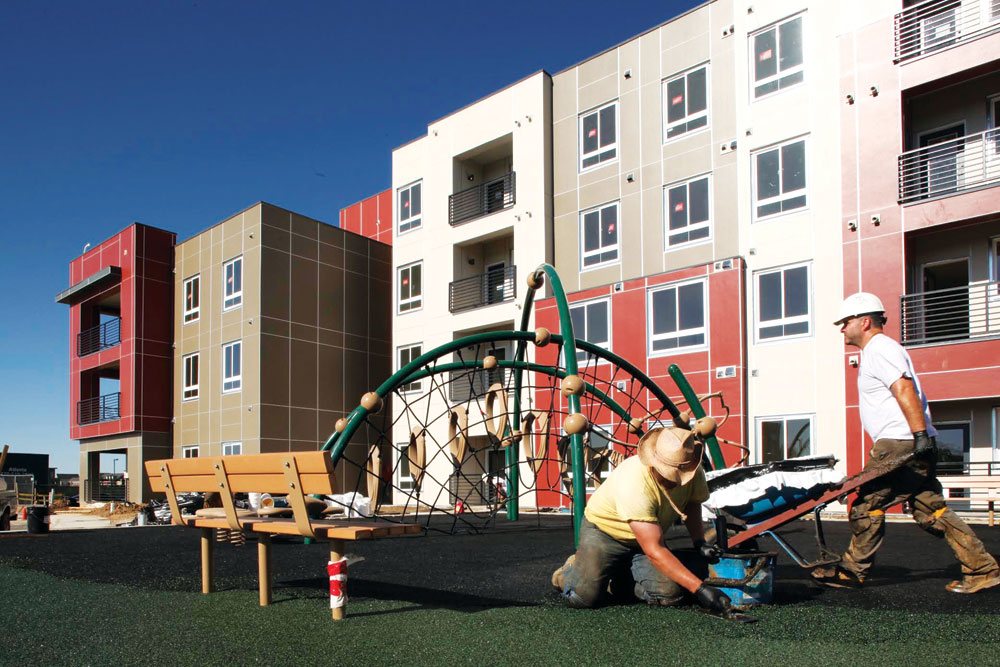Over 20 years ago, as forward-looking Denver residents helped plan the new neighborhood to be built on Stapleton airport land, having a diverse range of housing was high on their list. That decision was made at a time when affordable housing in most of the country was being provided in large public housing projects that were separated from more prosperous parts of the community.
Today the national housing policy is mirroring the diverse housing policy in the Stapleton Development Plan. The model of the future, says Rick Garcia, Denver’s regional administrator for Housing and Urban Development (HUD), is “housing units [that] are dispersed within the broader community and a mix of incomes … throughout the entire community.”
![]()
Affordable Housing in the News
Recently, a Supreme Court decision, a highly acclaimed new HBO series, and a Harvard research project that looked at the outcomes for children who grew up in poor neighborhoods but moved to a more affluent one, have all contributed to a national conversation on affordable housing. In Denver, the mayor is proposing that the city should have an ongoing sustainable source of funding for affordable housing. A summary of his proposal is on page 26.
The Supreme Court decision was a case decided in June in which a Dallas nonprofit sued the Texas Department of Housing and Community Affairs based on how they distributed federal funding for affordable housing. From 1995 to 2009, according to the lawsuit, all the locations that got funding had the same ghetto conditions that the Fair Housing Act of 1968 was meant to remedy. The question in this case was whether Texas needed to have the intent to discriminate to be found unlawful, or if their actions were unlawful because the outcome was discriminatory. The Supreme Court ruled, 5-4, that policies that segregate minorities, even if they are not intentional discrimination, do violate the Fair Housing Act.

18 of the 38 Spruce Townhomes, at MLK Blvd. and Spruce, are now completed. Similar affordable projects are planned in the future.

Gete Mekonnen, executive director of NE Denver Housing, speaks at the Jan. 2014 groundbreaking for the Spruce Townhomes.
Following just behind the court decision, the Affirmatively Furthering Fair Housing (AFFH) rule was released by HUD, which, Garcia says, complements the Fair Housing Act. “The intent is to be proactive and help communities get to the best decisions they can.” The goal is to help communities think through “the best and highest use” of federal resources for housing.
But not everyone agrees. There are those who believe these kinds of policies will impact the zoning authority of local governments. It doesn’t take much digging to find examples of neighborhoods in the U.S. that have resisted such policies that bring racial and economic diversity into their neighborhoods. The new HBO show, Show Me a Hero, is a stark example. The six-part series shows how the city of Yonkers, New York, rose up in the 1980s to resist a court order to build 200 units of low-rise subsidized housing in the mostly white middle-class area of that city.
The argument for dispersing affordable housing got a big boost this past spring with results from a huge research project that showed every year a child spends in a better neighborhood contributed to higher earnings at age 26—and the more years, the greater the increase. The Harvard study1 of more than 5 million children analyzed how moving across county lines impacted the prospects for upward mobility. “This delivers the most compelling evidence yet that neighborhoods matter in a really big way,” said David B. Grusky, director of the Center on Poverty and Inequality at Stanford University, in a New York Times article about the study2. (An interactive map in the online Times article shows that earnings at age 26 by children who grew up in Denver are well below the U.S. average.)
Old Perceptions and What “Affordable” Means Now
Getabecha “Gete” Mekonnen, director of Northeast Denver Housing for the past 30 years, acknowledges the need to educate the public to get past the old perceptions about affordable housing that came from concentrated and segregated public projects—a perception that has raised concerns about housing values and safety.
Potential buyers ask what the signs in Stapleton mean, wondering if there will be housing projects, says real estate agent Kim Kouba. Previously phrased as “Affordable” or “Income-qualified,” the signs now say “Future Site of Residential For Sale Homes Starting in the Mid $100s.” Kouba says when she explains what the affordable for sale program is, it changes things for buyers considering nearby properties. They realize “that neighbor is going to be just like me.” They will have a job and a mortgage and responsibility for the upkeep of their investment. Mekonnen says his organization requires affordable buyers to spend a minimum of six–eight hours at a workshop on financial planning and homeownership and have an individual session with a housing counselor. His organization builds a relationship with each client so they’ll come back if they get into any problems with their mortgage or their house.
“I don’t think it’s about income-qualified. I think it’s about density,” says Kouba. She has heard concerns when single-family homebuyers look at houses that adjoin higher or denser dwellings, which, oftentimes, are not affordable units. But, she also thinks people who choose to live in Stapleton have pretty progressive views on diversity and mixed incomes and they appreciate the different housing styles and sizes. And, she adds, the affordable units are attractive. “I think the income-qualified housing kind of fits into that eclectic feel.” In this market, she thinks nearby affordable has no impact on price. But when a buyer can pick from 25 homes, a whole range of factors such as busy streets, parking, density or affordable housing may affect their decision.
Mike Hagar, who is married and has two kids, ages 3 and 5, has lived near to NE Denver Housing’s 18-unit affordable rental complex on Central Park Blvd. near 23rd Ave. for eight years. He acknowledges the skepticism about affordable housing, but says, “In my experience it’s completely fine … When you move into a great neighborhood you can still have an idiot neighbor. You can move into a low-income neighborhood and have great neighbors. So it’s not really income dependent. It’s just luck of the draw sometimes.” When he moved to Stapleton he thought the nearby empty lot was going to be a park. When he learned the land would have affordable apartments, he was concerned they would affect his property value, but says, “To date I have not heard of any of the sellers needing to shave dollars off their selling price because of it.”
What Have We Learned?
Matt and Katie Wagner live next to the affordable apartments. The Wagners like Stapleton’s environmentally sound concept of small lots and nearby open space. They chose their particular location in 2005 because they were told the nearby empty lot would be a small park or open space. But the park didn’t happen and the subject brings back their old anger and bitterness about the misinformation. They say they are not mad about the affordable apartments, but Katie says, “I think it started off on the wrong foot, which is very challenging.” The Wagners and Mike Hagar all think transparency about future land use is the biggest lesson going forward.
Apart from the usual density issues (more cars in the alley, more likelihood that a trash can gets left in the alley, more children’s voices), Matt Wagner says living next to the affordable apartments has not been an inconvenience (and he adds that if you don’t like the sound of kids playing when you open your windows, you shouldn’t live in Stapleton).
Mekonnen acknowledges there may be incidences where kids and families aren’t the ideal, but overall believes their management is good. Katie and Mike agree with that, but like any neighborhood with small lots, when there is a problem, the next-door neighbor is the one who sees it, not the person two or three houses away.
Katie points out that organized efforts to help the neighbors get acquainted with the apartment residents would be helpful.
Mekonnen acknowledges that making the neighborhood socially seamless would be ideal, and maybe that’s something his organization could do a little bit better.
Then he explains that he’s working his way through five or six layers of financing for his next affordable for-sale units. For the 84-unit affordable rental building on Northfield Blvd. just west of the Staybridge Suites, he says there are 10 different layers of financing. Getting money for the physical building is hard enough. When he tries to add in a person, the financing people say, “Gete, I’m not paying for that.” But his organization is still committed to helping people who purchased homes through them, even if it was 20 years ago, and his plan is to continue that model.

The Bluff Lake affordable rental apartments near MLK Blvd and Havana, built and managed by Mercy Housing, opened in June 2012.
What Lies Ahead?
As of the latest statistics (first quarter 2015), with a total of 7,186 rental and for-sale units built, the affordable housing goals and achievements for Stapleton are:
- 10% of all for-sale homes should be “affordable” (currently 4.84%)
- 20 percent of rentals should be “affordable” (currently 22.4%)
- One-third of all residences should be rentals (currently 17.2%)
The 322 homes planned for the Aurora portion of Stapleton will not include an affordable program and will not have any rentals.
Tom Gleason, Forest City VP said, by e-mail, “We are setting aside lots as we go forward that will enable us to meet our affordable housing commitment.”
Maps of the currently know affordable sites in the southern portion of northeast Denver are available here and the affordable sites in the northern part of northeast Denver are available here, or at StapletonDenver.com/affordable. “I do not anticipate at this time that the lots marked for future affordable development will change, although it is always important to remember that all aspects of future development are subject to change,” Gleason wrote.
All affordable housing built in Stapleton is subsidized by Forest City with land provided at no cost, cash, or both—and combined with other subsidies for construction.
For information on upcoming affordable housing in Stapleton and qualifying for the affordable housing program, read about the upcoming affordable for-sale units in northeast Denver.
(1) “The Impacts of Neighborhoods on Intergenerational Mobility, Childhood Exposure Effects and County-Level Estimates” by Raj Chetty and Nathaniel Hendren, Harvard University.
(2) New York Times, May 4, 2015, “An Atlas of Upward Mobility Shows Paths Out of Poverty” by David Leonhardt, Amanda Cox and Claire Cain Miller.



Will you have affordable senior housing that someone on SSDI could afford? I recently left Denver after years of looking for safe and affordable housing housing.
Sorry to hear you left Denver for lack of affordable housing. It’s an unfortunate side effect of Denver being a desirable and rapidly growing city. The mayor will be here for a neighborhood meeting next week and we’ll be asking him questions about affordable housing in Stapleton.